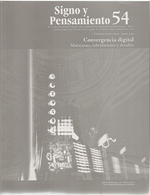Abstract
This article reflects on current cultural changes taking place in the act of reading when using digital aids and supports. These thoughts are then integrated around the question on the transformations which are also taking place in the communications’ ecosystem and its regimes and patterns, as a direct by-product of the condensation of new needs and interests in devices and routines associated to the use of technologies devised for reading. This paper is based on the author’s study of the practice of reading in a digital context presented to the Centro Regional para la Lectura y el Libro (CERLALC) earlier last year.
Briggs, A. y Burke, P. (2002), De Gutenberg a Internet. Una historia social de los medios de comunicación, Madrid, Taurus.
Bruner Jerome (1988) Realidad mental y mundos posibles: los actos de la imaginación que dan sentido a la experiencia. Barcelona. Gedisa.
Cassany, D. (2006), Tras las líneas. Sobre la lectura contemporánea, Barcelona, Anagrama.
Cassany, D. (2008), Prácticas letradas contemporáneas, México, Ríos de Tinta.
Castells, M. (1997), La era de la información, Madrid, Alianza Editorial.
Castells, M. (2003), “Una de las primeras sociedades informadas: las novedades y los medios de comunicación en el París del siglo XVIII”, en: El coloquio de los lectores, México, Fondo de Cultura Económica.
Gruzinski, S. (1995), La guerra de las imágenes. De Cristóbal Colón a Blade Runner, México, Fondo de Cultura Económica.
Gutiérrez, E. (2008), Comprender la comprensión, México, Ríos de Tinta.
Jewitt, C. (2008), “Multimodality and Literacy in School Classrooms”, en Review of Research in Education, núm. 32.
Maffesoli, M. (2004), El tiempo de las tribus : el ocaso del individualismo en las sociedades posmodernas, Barcelona, Siglo Veintiuno.
Manovich, L. (2002), The Lenguaje of New Media, Cambridge Massachusets, MIT Press. Martín-
Barbero, J. (2002), La educación desde la comunicación, Buenos Aires, Norma.
Mattelart, A. (1995), La invención de la comunicación, México, Siglo XXI Editores.
Murray, J. (1997), Hamlet en la holocubierta. El futuro de la narrativa en el ciberespacio, Barcelona, Paidós.
Olson Scott, R. y Pollard, T. (2004), The Muse Pixeliope: Digitalization and Media Literacy Education, en American Behavioral Scientist, vol. 48, núm. 2, Sage Publications.
Piscitelli, A. (2005), Internet, Barcelona, La Imprenta del Siglo XXI, Gedisa.
Ricoeur, P. (2001), La metáfora viva. Madrid, Trotta.
Scolari, C. (2004), Hacer clic. Hacia una sociosemiótica de las interacciones digitales, Barcelona, Gedisa.
Stiegler, B. (2002), La técnica y el tiempo, Hondarribia, Hiru.
Virilio, P. (1999), Cibermundo. La política de lo peor, Madrid, Cátedra.
Virilio, P. (2002), Ground Zero, Nueva York, Verso.
Vouillamoz, N. (2000), Literatura e hipermedia, Buenos Aires, Paidós.
INFORMES SOBRE LECTURA
E-brary (2008), 2008 Global Student E-book Survey, s.d.
National Endowment for the Arts (2007), “To Read or not to Read: a Question of National Consequence”, en: Research Report, núm. 47.
Patino, B. (2008), Rapport sur le livre numérique, Ministère de la Culture et de la Communication. Département de l’information et de la Communication.
Rey, G. et al. (2001), Hábitos de lectura y consumo de libros en Colombia, Bogotá, Fundalectura.
This journal is registered under a Creative Commons Attribution 4.0 International Public License. Thus, this work may be reproduced, distributed, and publicly shared in digital format, as long as the names of the authors and Pontificia Universidad Javeriana are acknowledged. Others are allowed to quote, adapt, transform, auto-archive, republish, and create based on this material, for any purpose (even commercial ones), provided the authorship is duly acknowledged, a link to the original work is provided, and it is specified if changes have been made. Pontificia Universidad Javeriana does not hold the rights of published works and the authors are solely responsible for the contents of their works; they keep the moral, intellectual, privacy, and publicity rights.
Approving the intervention of the work (review, copy-editing, translation, layout) and the following outreach, are granted through an use license and not through an assignment of rights. This means the journal and Pontificia Universidad Javeriana cannot be held responsible for any ethical malpractice by the authors. As a consequence of the protection granted by the use license, the journal is not required to publish recantations or modify information already published, unless the errata stems from the editorial management process. Publishing contents in this journal does not generate royalties for contributors.


